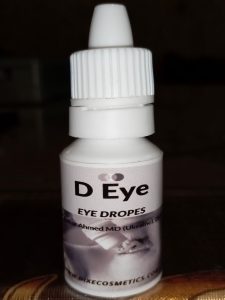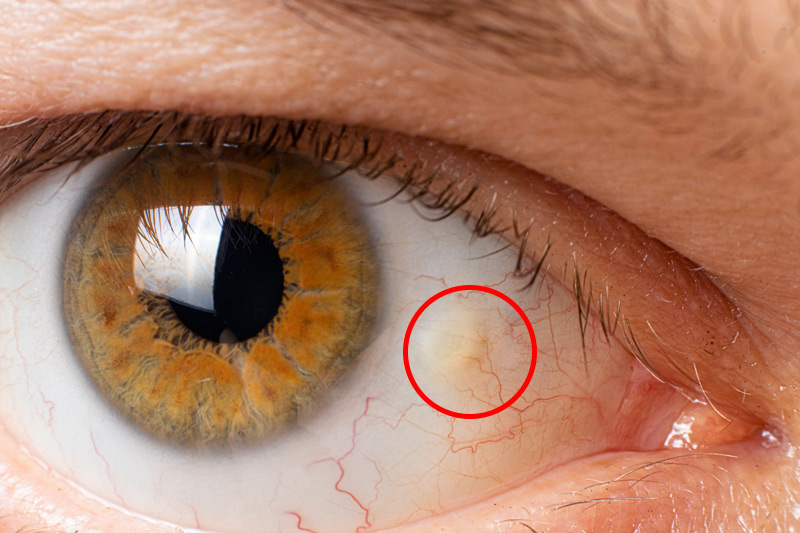A pinguecula Pinguecula Eye growth, is a noncancerous, growth that develops on the eye, and when there are more than one of them they are called “Pinguecula”.
Thank you for reading this post, don't forget to subscribe!These growths occur on the conjunctiva, which is the thin layer of tissue that covers the white part of our eye.
One can get pinguecula at any age, but they’re mainly found in middle-aged and elderly people.
In Allopathic theory, these growths rarely need to be removed, and no treatment is necessary in most cases (is it a joke or miss understood?).
While in Homeopathic theory they are the beginning of disease(s) which could be life threatening.
What does a pinguecula look like?
A pinguecula is yellowish in color and typically has a triangular shape. It’s a small raised patch that grows close to the cornea. Cornea is the transparent layer that lies over our pupil and iris (Iris is the colored part of our eye).
Pinguecula are more common on the side of cornea closer to the nose (inner side), but they can also grow next on the other side.
With the passage of time these pinguecula can become large, but this occurs at a very slow rate and is rare.
What causes Pinguecula?
A pinguecula forms when the tissue in our conjunctiva changes and creates a small bump. Some of these bumps contain fat, calcium, or both. The reason for this change isn’t fully understood, but it’s been linked to frequent exposers to dust, wind, high cholesterol levels, low intake of water, malnutrition etc.
Pinguecula also tend to become more common as people get older.
Symptoms of a pinguecula
A pinguecula can make your eye feel irritated or dry. Patient feels like he/she have something in his/her eye (sand or other rough particles). The affected eye might also itch or become red and inflamed.
These symptoms can be mild or severe.
Optometrist should be able to diagnose this condition based on the pinguecula’s appearance and location.
Differentiate pinguecula from Pterygium
Pinguecula and pterygium are types of growths that can form on the eye. These two conditions share a few similarities, but there are also notable differences between them.
Pinguecula and pterygium are both benign and grow near the cornea. They’re both linked to exposure to the sun, wind, cholesterol, malnutrition and other harsh elements.
However, Pterygium have a flesh-colored appearance and are round, oval, or elongated. Pterygium are more likely to grow over the cornea than pinguecula.
A pinguecula that grows onto the cornea is known as a pterygium.
How is a pinguecula treated?
Allopath philosophers said that “You usually don’t need any type of treatment for a pinguecula unless it causes discomfort” (they love to cut/to sale there drugs as more as possible, doesn’t matter how old or poor are you ??). If your eye does hurt, allopathic doctor just advise eye ointment or eye drops to just relieve redness and irritation.
Surgery is considered when a pinguecula:
- Grows over the cornea, as this can affect your vision
- Causes extreme discomfort when you try to wear contact lenses
- Is constantly and severely inflamed, even after you apply eye drops or ointments.
Surgery typically doesn’t lead to complications, although pinguecula can grow back afterward (is it funny ???).
Homeopathic Treatment of Pinguecula
D Eye drops
Cataract, Keratitis with intense chemises of ocular conjunctiva, Sclera raised in patches, Styes and tarsal tumors, Suppurative inflammation of eyes, Photophobia, Spots before the vision, Blurred vision, acrid lachrymation, Sticky mucus on cornea, Opacities, Catarrhal conjunctivitis, Pterygium. Thrombosis of retinal vessels and degenerative changes in retinal cells.
tumors, Suppurative inflammation of eyes, Photophobia, Spots before the vision, Blurred vision, acrid lachrymation, Sticky mucus on cornea, Opacities, Catarrhal conjunctivitis, Pterygium. Thrombosis of retinal vessels and degenerative changes in retinal cells.
Thuja Occidentalis
Ciliary neuralgia; iritis. Eyelids agglutinated at night; dry, scaly. Stys and tarsal tumors (Staph). Acute and subacute inflammation of sclera. Sclera raised in patches, and looks bluish-red. Large, flat phlyctenules; indolent. Recurring episcleritis. Chronic sclerites.
Apis Melifestida
Lids swollen, red, oedematous, everted, inflamed; burn and sting. Conjunctiva bright red, puffy. Lachrymation hot. Photophobia. Sudden piercing pains. Pain around orbits. Serous exudation, edema, and sharp pains. Suppurative inflammation of eyes. Keratitis with intense chemises of ocular conjunctiva. Staphyloma of cornea following suppurative inflammation. Stys, also prevents their recurrence.
Argentum Nitricum
Inner canthal swollen and red. Spots before the vision. Blurred vision. Photophobia in warm room. Purulent ophthalmia. Great swelling of conjunctiva; discharge abundant and purulent. Chronic ulceration of margin of lids; sore, thick, swollen. Unable to keep eyes fixed steadily. Eye-strain from sewing; worse in warm room. Aching, tired feeling in eyes, better closing or pressing upon them. Useful in restoring power to the weakened ciliary muscles. Paretic condition of ciliary muscle. Acute granular conjunctivitis. Cornea opaque. Corneal ulcers.
Arsenicum Album
Burning in eyes, with acrid lachrymation. Lids red, ulcerated, scabby, scaly, granulated. Edema around eyes. External inflammation, with extreme painfulness; burning, hot, and excoriating lachrymation. Corneal ulceration. Intense photophobia; better external warmth. Ciliary neuralgia, with fine burning pain.
Euphrasia Officinalis
Catarrhal conjunctivitis; discharge of acrid matter. The eyes lacrimation all the time. Acrid lachrymation; bland coryza. Discharge thick and excoriating. Burning and swelling of the lids. Frequent inclination to blink. Free discharge of acrid matter. Sticky mucus on cornea; must wink to remove it. Pressure in eyes. Little blisters on cornea. Opacities. Rheumatic iritis. Ptosis.
Belladonna
Throbbing deep in eyes on lying down. Pupils dilated (Agnus Castus). Eyes feel swollen and protruding, staring, brilliant; conjunctiva red; dry, burning; photophobia; shooting in eyes. Exophthalmos. Ocular illusions; fiery appearance. Diplopia, squinting, spasms of lids. Sensation as if eyes were half closed. Eyelids swollen. Fundus congested.
Nux Moschatata
Dryness of eyes, and sensation of dryness, which impedes movements of lids. In evening it is difficult to read by artificial light. Blindness then fainting. Profuse lachrymation and burning pains in eyes. Tension round eyes and in lids. Sensation of fulness in eyes, with contraction of pupils. Pulsating, pressing pain on a small spot over left eye. Illusions of vision: objects appear too distant, too large, or too small. Sees two objects instead of one. Weakness of sight. Blue rings around eyes.
Hepar Sulph
Pain, as if the eyes were driven, or drawn back, into the head. Painful and difficult movement of the eyes. Heat. Throbbing in and about the eye.-Pressure in the eyes, as from a foreign body (sand etc). Pain, as from ulceration, immediately above the eye, every evening. Inflammation of the eyes and of the eyelids, sometimes erysipelatous, with pain as of a bruise, and of excoriation, on being touched.
Pimples above the eyes, and on the eyelids. Specks and ulcers on the cornea. Nocturnal lachrymation and agglutination of the eyelids. Spasmodic closing of the eyelids (at night). Eyes prominent. Obscuration of the sight on reading. Photophobia by day, and by candle-light. The eyes ache from the bright light of day, when moving them. Confusion of sight, in the evening, by candle-light, alternately with clearness of vision. The objects appear to be red.
Gelsemium Sempervirens
Ptosis; eyelids heavy; patient can hardly open them. Double vision. Disturbed muscular apparatus. Corrects blurring and discomfort in eyes even after accurately adjusted glasses. Vision blurred, smoky. Dim-sighted; pupils dilated and insensible to light. Orbital neuralgia, with contraction and twitching of muscles. Bruised pain back of the orbits. One pupil dilated, the other contracted. Deep inflammations, with haziness of vitreous. Serous inflammations. Albuminuric retinitis. Detached retina, glaucoma and descemetitis. Hysterical amblyopia.
Calcarea Carbonica
Sensitive to light. Lachrymation in open air and early in morning. Spots and ulcers on cornea. Lachrymal ducts closed from exposure to cold. Easy fatigue of eyes. Far sighted. Itching of lids, swollen, scurfy. Chronic dilatation of pupils. Cataract. Dimness of vision, as if looking through a mist. Lachrymal fistula; scrofulous ophthalmia.
Phosphorus
Cataract. Sensation as if everything were covered with a mist or veil, or dust, or something pulled tightly over eyes. Black points seem to float before the eyes. Patient sees better by shading eyes with hand. Fatigue of eyes and head even without much use of eyes. Green halo about the candlelight. Letters appear red. Atrophy of optic nerve.
Edema of lids and about e eyes. Pearly white conjunctiva and long curved lashes. Partial loss of vision from abuse of tobacco, Pain in orbital bones. Paresis of extrinsic muscles. Diplopia, due to deviation of the visual axis. Amaurosis from sexual excess. Glaucoma. Thrombosis of retinal vessels and degenerative changes in retinal cells. Degenerative changes where soreness and curved lines are seen in old people. Retinal trouble with lights and hallucination of vision.
zincum Metallicum
Pterygium; smarting, lachrymation, itching. Pressure as if pressed into head. Itching and soreness of lids and inner angles. Ptosis. Rolling of eyes. Blurring of one-half of vision; worse, stimulants. Squinting. Amaurosis, with severe headache. Red and inflamed conjunctiva; worse, inner canthus.
For consultation about Eyesight, Eye Infection or Allergies, visit our clinic.
To order medicine by courier, please send your detailed symptoms at WhatsApp– +92319884588
 Dr. Sayyad Qaisar Ahmed (MD {Ukraine}, DHMS) ; senior research officer Dnepropetrovsk state medical academy Ukraine; is a leading Homeopathic physician practicing in Al-Haytham clinic, Umer Farooq Chowk Risalpur Sadder (0923631023, 03119884588), K.P.K, Pakistan.
Dr. Sayyad Qaisar Ahmed (MD {Ukraine}, DHMS) ; senior research officer Dnepropetrovsk state medical academy Ukraine; is a leading Homeopathic physician practicing in Al-Haytham clinic, Umer Farooq Chowk Risalpur Sadder (0923631023, 03119884588), K.P.K, Pakistan.
Find more about Dr. Sayyad Qaisar Ahmed at :
https://www.youtube.com/Dr Qaisar Ahmed
